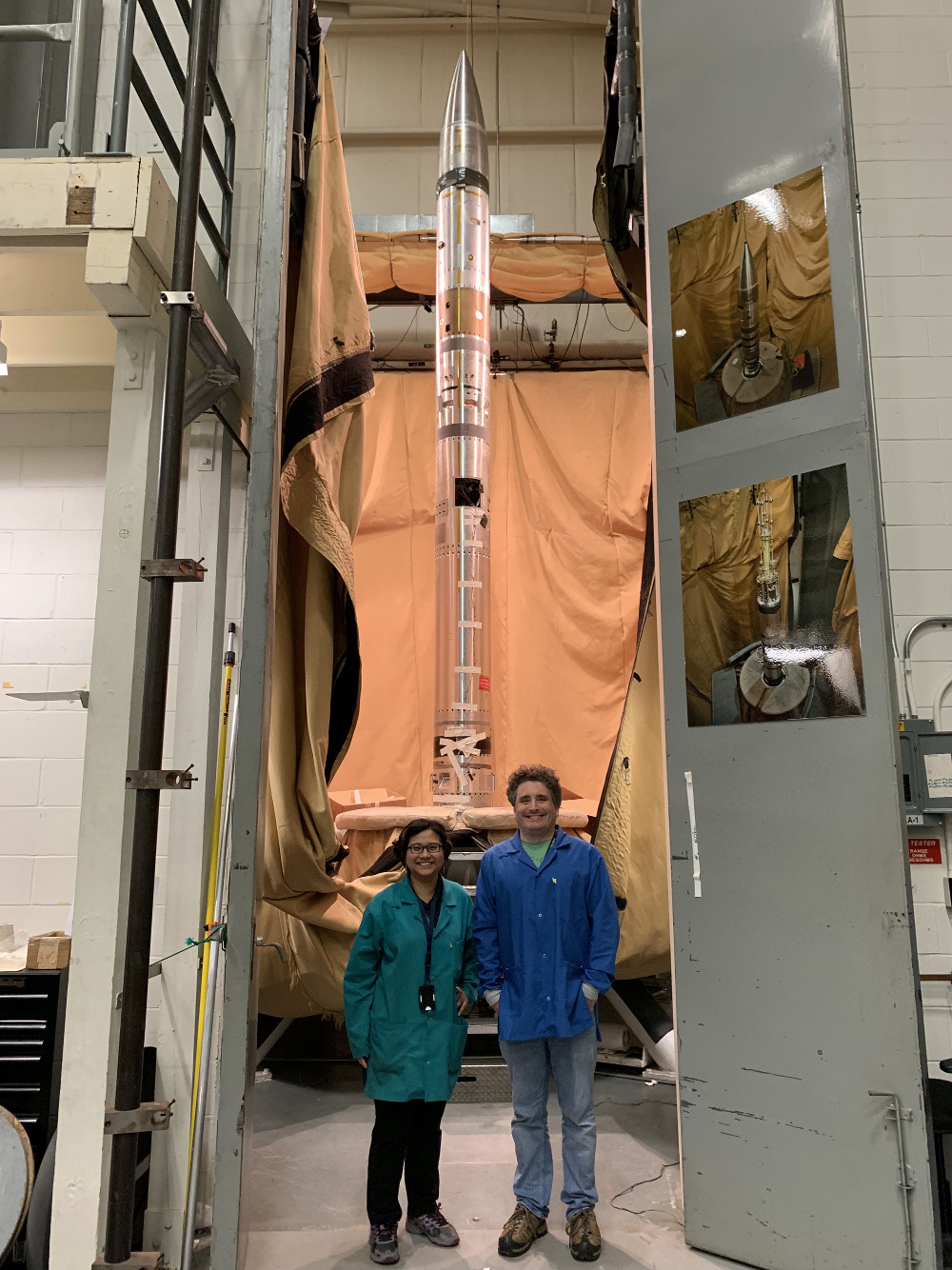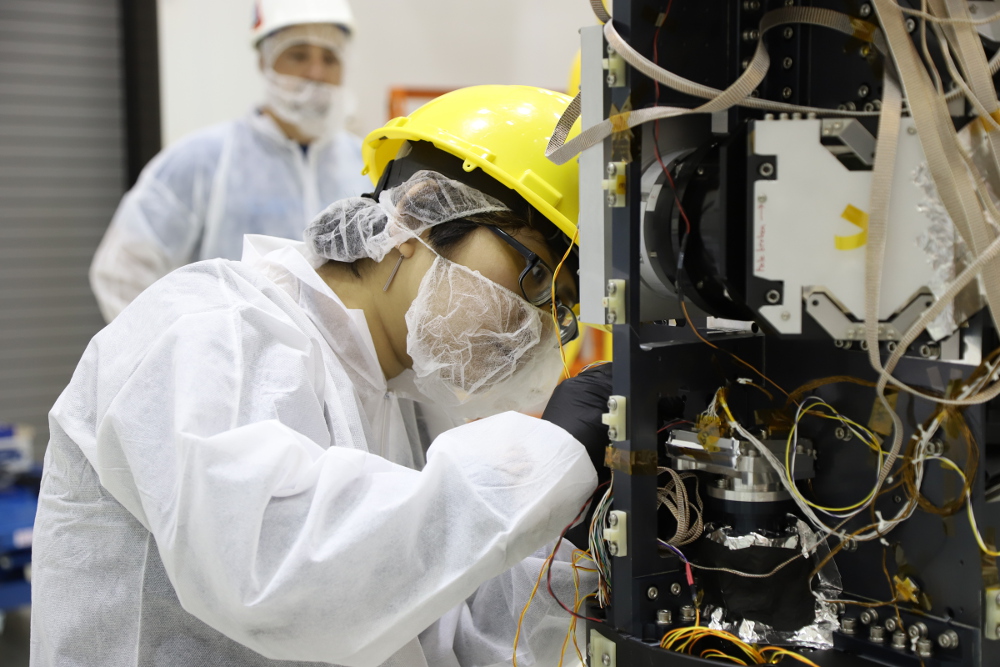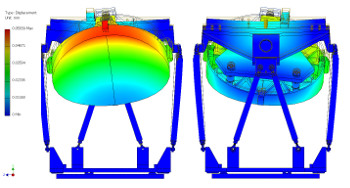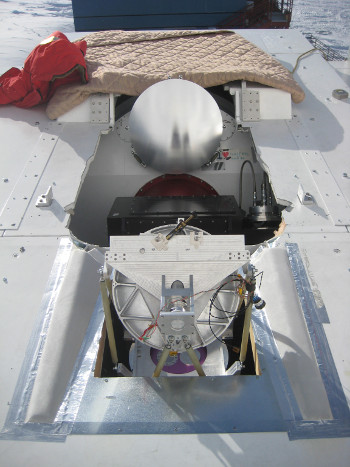
Nguyen and Zemcov standing in front of the CIBER-2 payload, integrated into the Black Brant IX rocket at Wallops Flight Facility, Virginia. Photo by WFF (2019)
Characterizing the EBL by the absolute count of photons is historically challenging due to the presence of bright local foreground emission, like stars/galaxies, light scattered off the dust in the Solar system (Zodiacal light) or in the Milky Way (diffuse galactic light). An alternative and successful technique is to map the fluctuations from the mean intensity in the observed EBL using multiple filters, then fitting the spectral and spatial energy distributions simultaneously to detect how much each component (EBL, foregrounds, etc.) contributes to the fluctuations.
Using intensity mapping, HST, Spitzer, Akari, CIBER-1, among others, have detected fluctuations that exceed what previous models predict for galaxy population up to redshift of 5. One possible source that can produce this excess fluctuation is the intra-halo light [1][2], which originates from stars that have been stripped from their host galaxies during mergers and now reside at the edge of the merged dark matter halo. However, further observations are still needed to confirm the intra-halo light contribution. I am working on the fabrication and integration of the Cosmic Infrared Background ExpeRiment 2 (CIBER-2) [3][4][5][6] which is designed to trace the source of the excess fluctuations and disentangle that source from the EBL. CIBER-2 uses a small telescope launched on a sounding rocket, to map the fluctuations in EBL intensity in the 0.5 - 2.5 micron window. Within this window, CIBER-2 will observe in 6 wavebands, enabling us to fit the spectral energy distribution better than in the previous CIBER-1 experiment.
-
[1] Zemcov, M. et al. "On the Origin of Near-Infrared Extragalactic Background Light Anisotropy" Science 346, 6210 (2014)
[2] Cooray, A. et al. "First Star Signature in Infrared Background Anisotropies" ApJ 606, 611 (2004)
[3] Nguyen, C. et al. "Integration and instrument characterization of the cosmic infrared background experiment 2 (CIBER-2)" Proc. SPIE 10698, 106984J (2018)
[4] Park, W. et al. "Development of data storage system and GSE for cosmic infrared background experiment 2 (CIBER-2)" Proc. SPIE 10698, 1069849 (2018)
[5] Shirahata, M. et al. "The cosmic infrared background experiment-2 (CIBER-2) for studying the near-infrared extragalactic background light" Proc. SPIE 9904, 99044J (2016)
[6] Lanz, A. et al. "Studying extragalactic background fluctuations with the Cosmic Infrared Background ExpeRiment 2 (CIBER-2)" Proc. SPIE 9143, 91433N (2014)

Installing the cryogenic star tracker (CSTARS-2) into the CIBER-2 payload. Photo by WFF (2019).
The New Horizons spacecraft has the advantage of being at the edge of the Solar system where the Zodiacal light is orders of magnitude fainter than at Earth distance, which means that it may be able to measure the cosmic optical background (COB) without contamination from the Zodiacal light. During its cruise phase to Pluto, the LORRI (LOng Range Reconnaissance Imager) instrument onboard the space craft regularly took short exposures to verify that the instrument was operational. In 2016 I developed a pipeline to select useful images from the New Horizons archive in order to test the feasibility of using LORRI to measure the COB. Despite the small statistics due to the size of the data available at the time, a measurement of the COB was made which is consistent with previous values from other missions [1].
-
[1] Zemcov, M., Immel, P., Nguyen, C., et al., Measurement of the cosmic optical background using the long range reconnaissance imager on New Horizons. Nat. Comm. 8, 15003 (2017) doi: 10.1038/ncomms15003.

Rendered with Autodesk Inventor 2015.

Photo by D. Marrone (2015)
REceiver Selection and Calibration Unit for EHT - SPT (RESCUES)
The Event Horizon Telescope (EHT) [1] [2] uses Very Long Baseline Interferometry (VLBI) to combine radio telescopes all over the world into the equivalent of an Earth-size mirror. It will directly image the immediate surroundings of Sagittarius A* (Sgr A*), the supermassive black hole (SMBH) at the center of our galaxy.The 10-m South Pole Telescope (SPT) provides EHT with its longest baselines, which will significantly improve EHT resolution. To prepare SPT for EHT, a VLBI receiver was built with its own optics system. In my senior thesis, I designed a removable mount for the third mirror in the VLBI optics which also features a remotely-controlled thermal calibration system, named RESCUES. The biggest challenge in this project is ensuring that RESCUES can operate in the harsh antarctic environment that the third mirror is be exposed to. RESCUES was successfully installed at the South Pole and first light was detected in 2015.
-
[1] The Event Horizon Telescope Collaboration et al., First M87 Event Horizon Telescope Results. I. The Shadow of the Supermassive Black Hole. ApJ Letter 875 (2019)
[2] The Event Horizon Telescope Collaboration et al., First M87 Event Horizon Telescope Results. II. Array and Instrumentation. ApJ Letter 875 (2019)